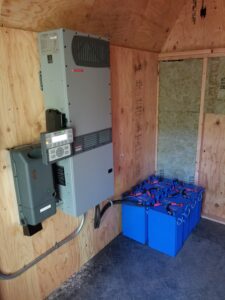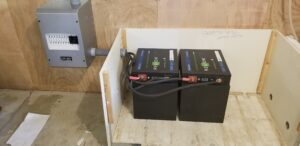Solar Battery Don’ts – FLA & AGM Batteries
Solar Battery Don'ts - FLA & AGM Batteries
An energy storage solution (batteries), with or without solar or another renewable charging source, is an investment in your home and your peace of mind. You can find “How To” guides when shopping for, installing, and caring for your home battery system. But you also need to know what not to do! To protect your investment in flooded lead acid (FLA) or Absorbed Glass Mat (AGM) batteries, do not make these mistakes!
 Don’t Add New Batteries to Older Batteries
Don’t Add New Batteries to Older Batteries
If you are thinking about starting with a small battery bank and adding more batteries over time, we highly recommend you reconsider. Combining different age batteries in a single battery bank will reduce the capacity and efficiency of the newer batteries – so much so that your newest battery will now only perform as well as the oldest battery in the bank. This is the same reason that we advise against combining different types or sizes of batteries into the same bank. Instead, either hold off until you can purchase the best size of battery bank for your application or purchase other parts of your power system in phases (inverters, solar panels).
Don’t Oversize Your Charging Source
For the health of your equipment it is vital that your battery bank can be charged within the manufacturer’s specifications for amperage – also know as the charge rate. Charging at too high of a charge rate can damage batteries and be dangerous, so it is important that your charging source isn’t oversized for the size of your battery bank.
Don’t Undersize Your Charging Source
A charging source that is too small for your battery bank can also create problems. To ensure you have the power you want when you need it, and that your batteries can be recharged within a reasonable amount of time, be sure you have adequate charging capabilities. Otherwise it may take days to recharge your batteries, or your batteries could be damaged due to chronic undercharging.
Don’t Expose Your Batteries to the Elements
 Batteries do not perform well under extreme temperatures. Allowing batteries to freeze will reduce their capacity to 50% of normal, and also can damage the batteries when the water or chemicals inside them expand. Overheating batteries makes them less efficient, and in extreme cases can lead to thermal runaway, a very dangerous condition. In less extreme cases chronic overheating can damage the chemistry and reduce capacity over time. It is simple to ensure your battery system is protected. Put it in a well ventilated but protected and insulated location that will keep your batteries within the manufacturer’s recommended temperature range.
Batteries do not perform well under extreme temperatures. Allowing batteries to freeze will reduce their capacity to 50% of normal, and also can damage the batteries when the water or chemicals inside them expand. Overheating batteries makes them less efficient, and in extreme cases can lead to thermal runaway, a very dangerous condition. In less extreme cases chronic overheating can damage the chemistry and reduce capacity over time. It is simple to ensure your battery system is protected. Put it in a well ventilated but protected and insulated location that will keep your batteries within the manufacturer’s recommended temperature range.
Don’t Undersize Your Battery Cables
Undersized cables can create a drop in voltage, resulting in system performance issues that are inexpensive and easy to avoid. Don’t skimp on your cables!
